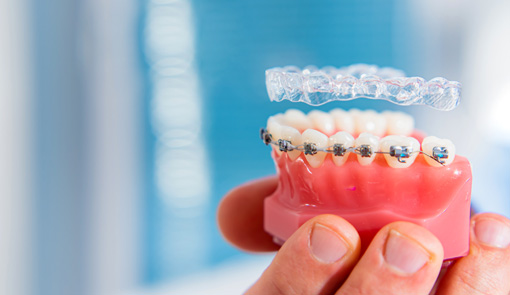If you have crooked teeth and want to take the first steps to correct your smile, you may not know which option works best for you. Both traditional braces and clear aligners, like Invisalign, are effective solutions that gradually straighten teeth. Our experienced team at Journal Square Dental can help you make the best decision that gives you long-lasting, exceptional results. It’s important to consider factors like the level of correction required, your lifestyle, and the restrictions involved with each treatment to determine which method is right for you.
With over 25 years of experience providing high-quality dental services, you can trust Journal Square Dental to provide the care and compassion you need to have a smooth, stress-free experience. We support you before, during, and after your treatment so that you always know what to expect and have the knowledge you need to understand the difference between braces and Invisalign.
Table of Contents
Toggle5 Factors to Consider When Choosing Between Braces and Invisalign
Traditional braces use stainless steel bands, brackets, and wires to shift your teeth slowly. In contrast, clear aligners like Invisalign are custom-made plastic trays that guide your teeth to their appropriate positions. While both of these treatments correct crooked teeth, it’s essential to consider the following factors when determining which would be best for you:
Appearance
Traditional braces are made of metal and fit on the outside of the teeth, making them visible when you talk, eat, or smile. Invisalign, on the other hand, fits closely to your teeth and is made of clear plastic, making it nearly invisible from a distance. This discreet appearance is a major reason many adults choose Invisalign over traditional braces.
Complexity of Corrections
While Invisalign offers a more aesthetically pleasing solution to crooked teeth, they can only correct mild to moderate cases. Traditional braces are a more universal solution that can correct all levels of crooked teeth. Our seasoned professionals at Journal Square Dental closely assess your teeth to determine if Invisalign can straighten your smile or if you need braces instead.
Treatment Length
In addition to discretion and the complexity of your corrections, timing may also play a role in your decision. Traditional braces take an average of two years to complete, while Invisalign typically takes six to 24 months, depending on your unique smile.
Discipline Needed
Invisalign trays are removable and must be worn for 20 to 22 hours daily to correct your smile on time. This requires more discipline than traditional braces, which are fixated on your teeth and cannot be removed without a professional’s help. For this reason, young children or those who need a more straightforward treatment may work better with traditional braces than clear aligners.
Care Required
Both Invisalign and traditional braces have restrictions and require specific home care. For example, clear aligners must be removed before eating and drinking anything other than water. Invisalign users must also brush their teeth before putting their aligners back in. However, those with traditional braces cannot eat foods like gum, popcorn, and hard candy that will get stuck in their braces. Considering which solution suits your lifestyle better can make this decision easier.
Learn More About Braces and Invisalign from the Knowledgeable Team at Journal Square Dental in Jersey City, NJ
Clear aligners are a nearly invisible, comfortable solution for crooked teeth, but they may not be for everyone. For those who need more complex corrections and discipline with their treatment, traditional braces may be the more effective option. At Journal Square Dental, we understand this decision can be challenging to make on your own, so we work closely with you to develop a personalized treatment plan tailored to your unique needs.
Are you ready to start your journey to a healthy, even smile? Take the first steps to renewed confidence by calling us at (201) 431-0288 or filling out our contact form today.


